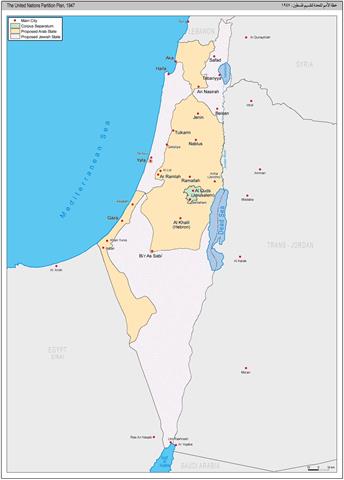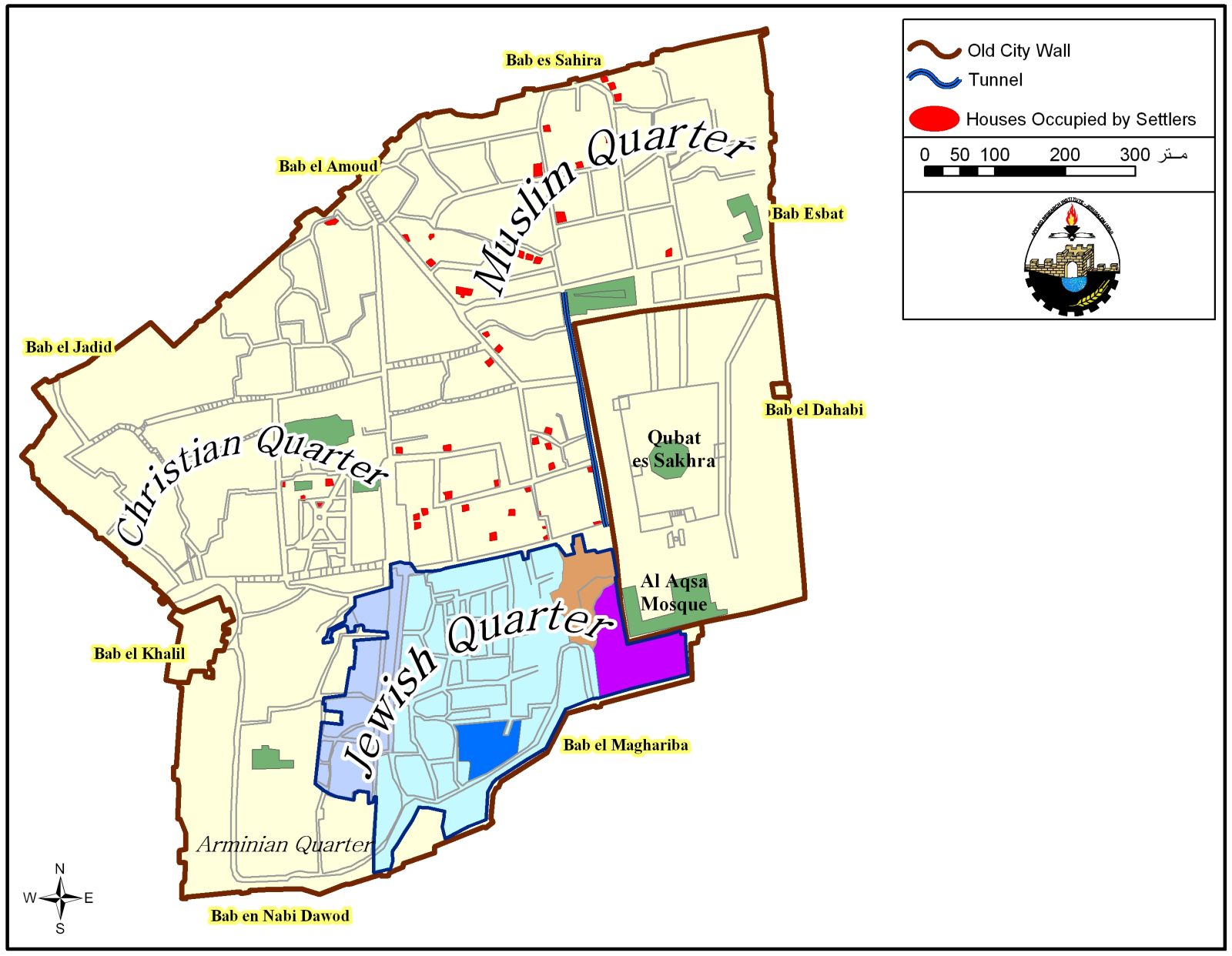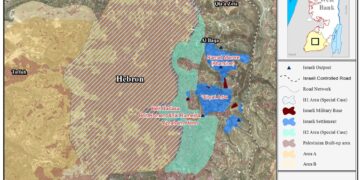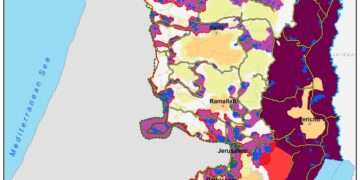Background:-
Jerusalem city has been for a long time the heart of the Palestinian-Israeli conflict. The question of a Palestinian statehood is still unresolved and has gained most of the attention of the world due to its great importance historically, culturally and economically.
On November 29, 1947, the UN General assembly (Resolution No. 181) endorsed the partition of Palestine into two states, Jewish and Palestinian state. As a result, Palestinians rejected the plan since it diminishes any future claim of a Palestinian; besides, it ignored the rights of the majority of Palestinian inhabitants in that time. The resolution stressed on the fact that Jerusalem- a corpus separatum, a special entity to be run under the mandate of UN administration and the territory of Palestine should be divided as follows:
-
A Jewish State covering 56.47% of Mandatory Palestine (excluding Jerusalem)
-
An Arab State (Palestinian state )covering 43.53% of Mandatory Palestine (excluding Jerusalem). See Map 1
During that time, Jews only owned 7% of the land and Palestinians owned the rest which is 93%.
Israeli activities in the occupied territories following the 1948 opposed the United Nations principles and the provisions of Council resolutions. These violations led to the destruction of the Palestinian culture and the creation of unsettled Palestinian refugee problem where 600.000 to 700.000 Palestinians (depopulation of 418 Palestinian villages) were disposed /evicted from their villages by the Israeli Government in 1948 and led to the creation of an ''Israeli state''. The Israeli occupation continued its policies in the occupied territories through border closures, preservation of natural resources, destruction of Palestinian houses, properties and illegally established Israeli settlements.
Soon after the 1967 war, Israel has pursued an intensive development programs in Jerusalem and the surrounding areas. Israel's intensive colonial (development: as referred to by Israelis) programs after the 1967 war has involved the construction of new housing units and associated infrastructure in the unilaterally annexed and expanded territory of occupied East Jerusalem. In addition to the evacuation of entire Arab neighbourhoods such as ''Al Maghareba'' neighbourhood which was levelled to the ground making space for the Wailing Wall Plaza to be constructed. Over the years, Israel was able to take control over 55 locations in the old city of Jerusalem, causing the transfer of huge number of Palestinians. Besides, a number of Jewish Organizations such as Kach, Gush Emunim, Ateret Kohanim and the so-called 'Temple Mount Faithful played a critical role in making the Israeli dream come true.
Israel grappled with its colonization strategies/policies to renew and reinforce its presence in Jerusalem, to rush the transfer of Palestinians through confiscating their lands and evicting them from their homes, thus making any possible solution unattainable. In East Jerusalem, Israel expanded its borders following the 1967 war from 6.5 km2 to 71 km2 to cover more areas for its colonial projects. Those expanded borders were drawn to include more vacant land from Bethlehem and Ramallah and leave Palestinians with little Palestinian built up area.
Ateret Kohanim!!!
Yeshivot Ateret Cohanim, a Jewish organization, presently located in the Old City, considers itself as a national movement for renewing and strengthening the Jewish operational readiness level in the heart Jerusalem. They believe deeply in the importance of reestablishing a Jewish presence in Jerusalem Old City. There is even a list of people living their, about sixty families counting a 1000 Jewish residents. It is one of the main donors who bought great deals of property in East Jerusalem, thus strengthening the Jewish existence in Jerusalem city. Throughout the years, this Jewish organization has raised tens of millions of dollars from wealthy Jews to reinforce the Jewish presence in the heart of East Jerusalem. Among the projects:
1. The Project for the Restoration of Jerusalem which was founded in 1977 with the help of Canadian millionaire Mark Belzberg, and Prime Minister Netanyahu.
2. In 1989, Ateret Kohanim attained St. John's Hospice in the Christian Quarter which had belonged to the Greek Orthodox Church.
3. The opening of the tunnel at the Western Wall in 1996.
4. The Construction of a Jewish neighborhood in Ras al-Amud in Jerusalem administered by Yossi Kaufman, Head of Ateret Kohanim Yeshiva and the Jerusalem Municipality who approved the plan to build 132 apartments on the 15-dunam site in 1998). See Map 2
The Organization further expanded its colonial activities when it announced on the 30th of April 2004 to take over 16 houses/ housing units belonging to Palestinians and located inside the Old City of Jerusalem. In a written statement distributed by the organization to residents living in the area, stated that residents should leave the neighborhood for the purpose of establishing a religious school and a synagogue in the heart of Islamic neighborhood in Jerusalem Old City. The organization also claims its ownership of the sixteen houses.
Violation
On the first of May, 2004, four families of Jewish settlers belonging to Ateret Kohanim movement, equipped with generators and other personal items
moved into two homes in the Arab East
Jerusalem neighborhood of Abu Dis. Settlers were guarded by Israeli troops who secured the settlers during the process in addition to other 150 members of the organization who came to support the families. The provocative act aims at establishing a new colonial compound to be known as 'Kidmat Zion' on the eastern side of the city and close to the segregation Wall that is being built in the moment in Abu Dis City which threatens the future peace plans due to its closeness to the Palestinian built-up areas, the Palestinian Parliament building (Palestinian Legislative Council) and Al Quds University.
A contiguity Plan:-
In a previous incident, on 29th of April 2004, the Israeli army took over the four-story Cliff Hotel located next to the two houses that were occupied by Ateret Kohanim settlers and lies on the western side of the Wall. The Hotel is also 50 meters away from the Palestinian Legislative Parliament and Al Quds University. See Map of violation (Map 3)
Palestinian owners estimate the area on which the two houses are built in addition to the Hotel by 2 dunums; thus, this Israeli activity comes in continuation of the previous plans to reinforce and extend the Jewish existence in East Jerusalem such as:
1. The Islamic Neighborhood in Jerusalem Old City
2. Moving to the Christian quarter in Jerusalem city where a number of 60 Jewish families live
3. To then continue to ('Ma'ale Zeitim') in Ras Al Amoud which is currently inhabited by 37 families and financed by by Irwin Moskowitz
4. Followed by the establishment of Ateret Kohanim site in Al Thawri neighborhood which houses 4 Jewish families
5. Taking over a house in Al Yaman neighborhood in Silwan city and end with occupying the two houses in Abu Dis. See Map 4
Cliff Hotel and the Jerusalem Envelope Plan
The Israeli so-called Jerusalem Envelopepenetrates Abu Dis city through the construction of the Segregation Wall that is currently being constructed and detaching some 6000 Dunums of agricultural land in the area out of 28,232 Dunums (11,293 Acers) which is considered the city's total area. See map 5 & Map 6. & .
Cliff Hotel lies in the area where the Segregation Wall is about to be constructed. An appeal was handed by Abu Dis residents in January 2004 to the Israeli Supreme Court asking for reconsidering the case of building the Segregation Wall in that area. Ayyad Family, the owners of the Hotel said that if the appeal is rejected then the Hotel will remain outside the Wall borders; thus segregating it from their access and Jerusalem city as well;
History of the Hotel:-
Cliff Hotel was first built in 1954 by Abdel Hadi Ayad who was an officer in the Jordanian army. Ten years later, Mr. Abdel Hadi renovated the house to accommodate Diplomatists and tourists. The Hotel was used following the 1967 war as a resort for Psychological treatment for Jews who were transferred from West Jerusalem and the family, during that period of time, paid its monthly dues to the Israeli civil administration for it was registered as a Touristic project in the West Bank.
The Hotel was occupied by the Israeli army in 1996 who turned it into a military watch point for a couple of weeks period of time. Ayyad family got their Hotel back after appealing to the Israeli Supreme court who accepted the appeal and ordered the military to evacuate the Hotel.
During the period of 1996 and 1997, the Hotel was subjected to a number of attacks by the Israeli army, again trying to take over the Hotel but failed to achieve their plans.
Ayyad Family rehabilitated for the second time the Hotel in 1997 hoping to commence a new stage of work due to the prosperous period the West Bank was witnessing that time. Three years later, the second Intifada erupted and the Hotel was used as accommodation for students attending Al Quds University from various parts of the West Bank.
In 2002, Ayyad family received a written statement signed by Amos Yaron, General Director of Ministry of defense assuring the location of the Hotel inside the Jerusalem borders and declared it as part of the state property according to Israeli law of Absentee in 1949 which states that ''any Palestinian who left Palestine after November 29, 1947, the date of the UN partition plan, to any country, meaning all the neighboring Arab countries, or to any part of what later became the West Bank and Gaza, or to any part of what became Israel in '48, but wasn't under the '47 partition plan. The property of absentees, all the property, both moveable and immoveable, becomes the property of the Custodian.''
The family again appealed to the court asking for the abolition of the order. The order was cancelled soon after the court discovered that the law has been mistakenly implemented simply because
-
The family has never been a custodian of Israel
-
The Fact that Ayyad family members were considered as residents of the West Bank after the occupation of East Jerusalem by the Israeli army in 1967 and the supervision of the Israeli civil administration since that time to handle their matters doesn't give them the right to confiscate their properties.
Nowadays, Abu Dis is facing the threat of Wall construction that aims at besieging the town from its northeastern and northwestern sides. A number of 11 Israeli military orders were issued for land confiscation during the year 2003 for the construction of the so-called Israeli ''Security Wall'' in Abu Dis city which houses a population of 11,413 Palestinians residents and the nearby cities of Al-Sawahereh Al-Sharqieh (Population: 4,910 residents), Ash-Sheikh Sa'd (Population: 2,267 residents) and Al-Eizariya (Population: 16,395 residents). The military orders consumed approximately 971.8 dunums, a total length of 21.08 Km of Palestinian land; Click here for related article 1
In late December 2003, the Israeli government started the second stage of constructing the Segregation Wall in Abu Dis area where the first stages of construction were undergoing during the year 2003. The wall, rigging-up 8 meters (27 feet) cement partitions is few meters away from the Palestinian Legislative Council (PLC) located in the heart of Abu Dis and its route will disrupt the lives of thousands of Palestinian residents living in the town.
Conclusion:-
The goal behind such Israeli action is to cerate a contiguity with the Jewish neighborhoods that has been established in Jerusalem Old City and Ras Al Amoud neighborhood along with Silwan city which is now threatened by further colonization projects as well as Jabal Al Mukabbir where a new project is under construction, and Shiekh Jarrah neighborhood which is faced up by daily violations in which Jewish settlers are trying to make the life of Palestinian residents infernal.
Creating facts on the ground changes the parameters of a permanent solution to the Israeli- Palestinian conflict. Israel's expansion of Jerusalem's illegal boundaries and separation of Jerusalem city from its Palestinian neighborhoods are clear example of de facto policies that aim to augment the course of the negotiations over Jerusalem and a clear implementation of Israel's Prime Minister Ariel Sharon's old- new plan.
Prepared by:
The Applied Research Institute – Jerusalem



















